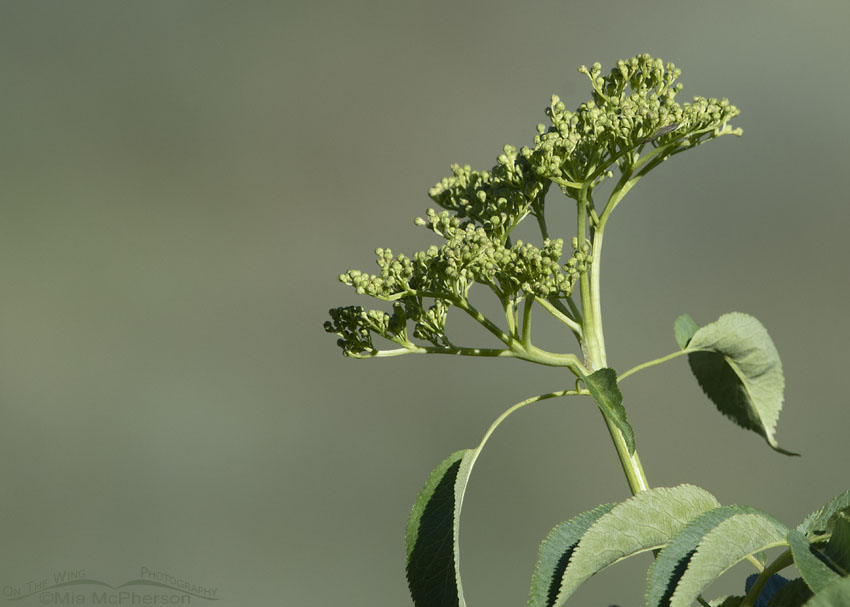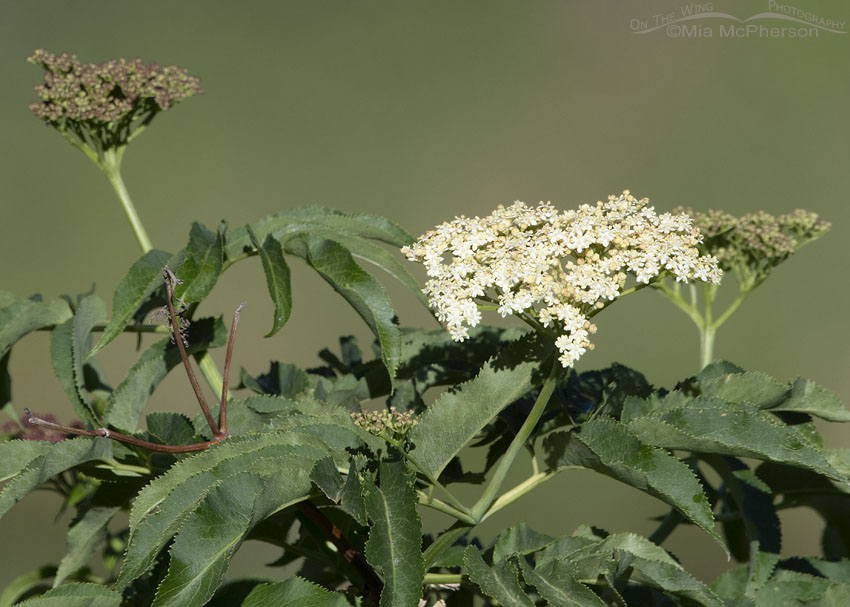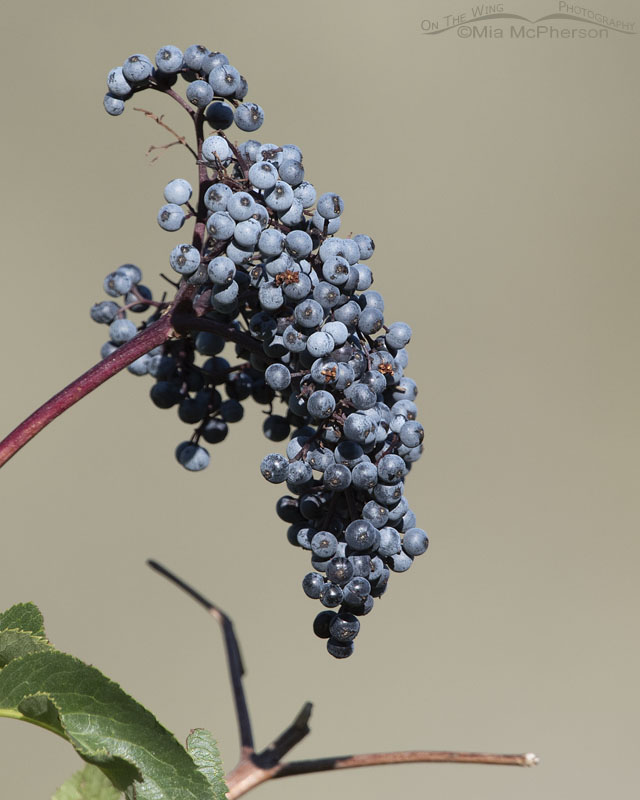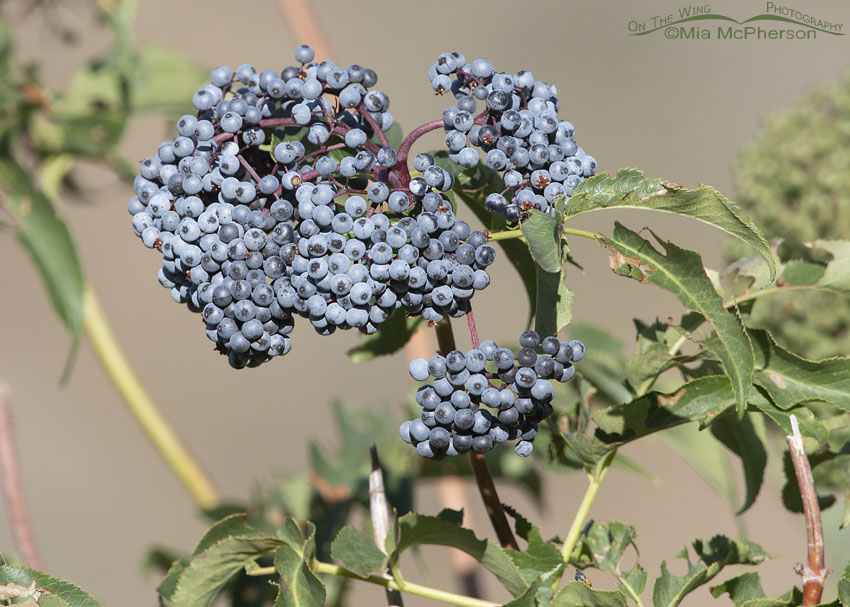Another non-bird post this morning about Blue Elderberry shrubs which are a native food source for birds, wildlife, and people too. I’ve photograph this particular Blue Elderberry up in a Wasatch Mountain canyon for several years. The first two photographs are from this spring and the last two are from late last summer.
 Blue Elderberry flower buds – Nikon D500, f10, 1/1000, ISO 500, -0.7 EV, Nikkor 500mm VR with 1.4x TC, natural light
Blue Elderberry flower buds – Nikon D500, f10, 1/1000, ISO 500, -0.7 EV, Nikkor 500mm VR with 1.4x TC, natural light
Blue Elderberry shrubs are native to this part of the country and are a member of the honeysuckle family. These shrubs can grow up to 25 feet in height. I see quite a few elderberry shrubs up in the mountain canyons I visit while looking for birds to photograph.
 Blooming Blue Elderberry – Nikon D500, f10, 1/1250, ISO 500, -0.7 EV, Nikkor 500mm VR with 1.4x TC, natural light
Blooming Blue Elderberry – Nikon D500, f10, 1/1250, ISO 500, -0.7 EV, Nikkor 500mm VR with 1.4x TC, natural light
Blue Elderberry blooms are creamy white in coloration and are borne on umbels. The leaves are a dark green and they are finely serrated on their edges. I’m sure there are many pollinators that visit these flowers while they are in bloom.
 Berries of Blue Elderberry – Nikon D500, f7.1, 1/1250, ISO 400, Nikkor 500mm VR with 1.4x TC, natural light
Berries of Blue Elderberry – Nikon D500, f7.1, 1/1250, ISO 400, Nikkor 500mm VR with 1.4x TC, natural light
The fruits of Blue Elderberry are a dark, dusty blue color when they are ripe. They remind me of the blueberries I used to grow in my garden. Wildlife that eat the berries or the foliage include bears, elk, deer, moose, squirrels, and chipmunks. I also believe that cattle eat the foliage and this week noticed that this shrub had lots of leaves stripped off from its base that had been attached to the shrub last week. I had seen cattle in the area and suspect that they were munching on the leaves.
 Clump of Blue Elderberry berries – Nikon D500, f7.1, 1/1000, ISO 400, Nikkor 500mm VR with 1.4x TC, natural light
Clump of Blue Elderberry berries – Nikon D500, f7.1, 1/1000, ISO 400, Nikkor 500mm VR with 1.4x TC, natural light
Some of the birds that eat the berries include bluebirds, buntings, sapsuckers, house finches, flickers, grosbeaks, jays, kinglets, mockingbirds, nuthatches, orioles, sparrows, tanagers, thrashers, thrushes, towhees, waxwings, warblers, woodpeckers, wren-tits, grouse, pheasants, and doves. I imagine that some of the larger birds eat the fruit from the ground when the berries fall off.
People eat the ripe Blue Elderberry berries raw and the berries can be used to make wine, juices, jelly, jams, teas and pies. Me… I’d rather leave the berries for the birds to eat.
The berries on the Blue Elderberry shrub I photographed haven’t yet ripened this year but when they do I would like to visit the shrub often to see what birds I might find feeding on the juicy berries.
Life is good.
Mia
Click here to see more of my wildflower, tree, and shrub photos.
Blue Elderberry goes by other names which include elder, blue elder, Arizona elderberry, American elder, sweet elder, wild elder, flor sauco, tree of music, Danewort, Walewort, New Mexican elderberry, velvet-leaf elder, hairy blue elderberry, and dwarf elder.


Hmm did not know that was what the plant is called. Do they grown in the mountains or just down on the plains? Guess I need to look it up. We have something like that in the mountains, but afraid to eat any, I was thing they have a strong sour taste to them. May have tried one once. lol I am now following your posts. Thank you.
Beautiful things.
Thank you for your focus on our very best artist’s work. Nature has an incredible palette and spectacular galleries.
Ditto Patty’s comment! I also now have Elton John’s Elderberry Wine going through my head.
Nobody photographs flowers, plants better than Mia Eagle Eyes McPherson!!! These are beautiful…I just finished a jar of Elderberry jelly I bought by mistake, meaning to get Boysenberry…it was very good…